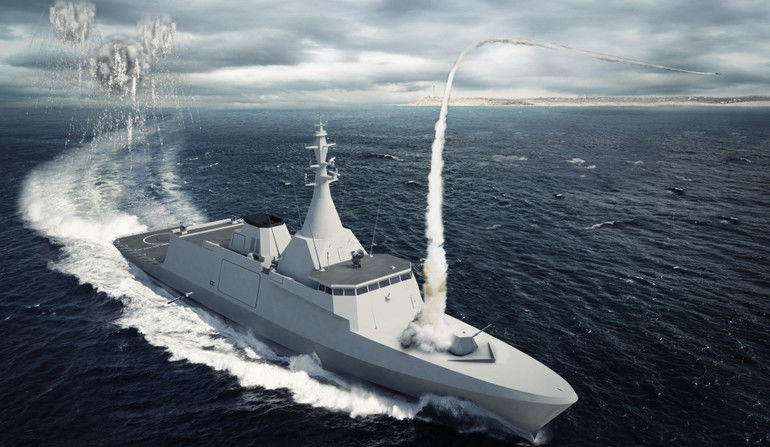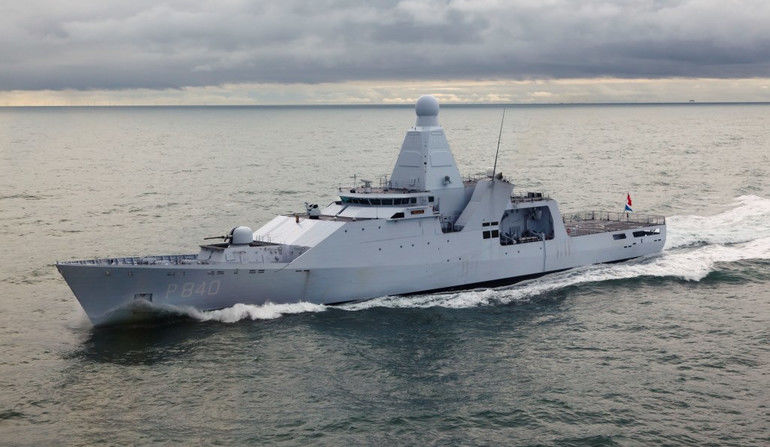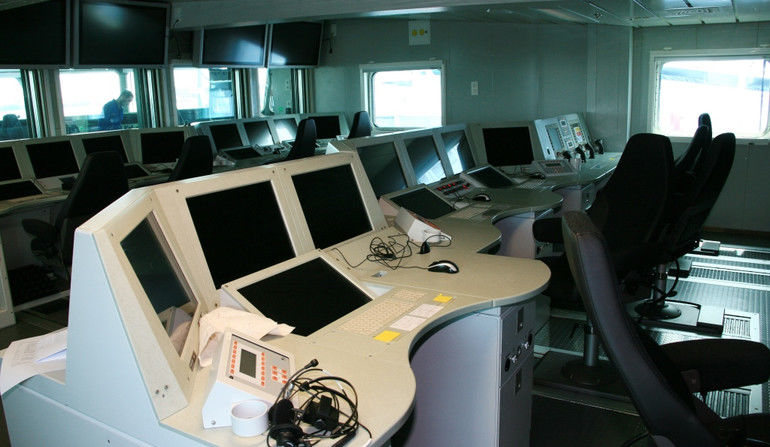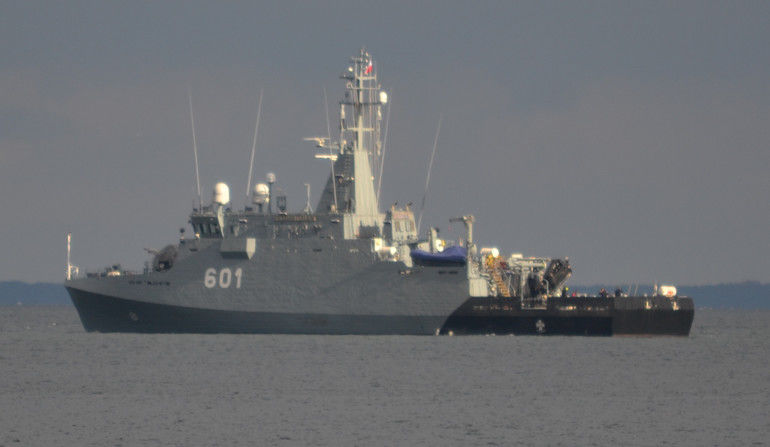“Ślązak” Vessel – 20 months overdue? Delayed Reconstruction Works. Transformation of the Corvette into a Patrol Vessel

According to the unofficial data, “Ślązak” Patrol Vessel is going to be handed off to the Polish Navy on 31st July 2018, 20 months after the assumed deadline – November 2016. Not only is it the Contractor’s fault, as the Ordering Party has also contributed to the delay, and unfortunately, we may potentially witness such situation being repeated in case of any of the future Polish Navy vessels. Initially, the construction works related to the Gawron combatant, designed as a corvette, began back in 2001. Hence, the whole process may take 17 years in total.
Still, no official release has been issued, referring to the date on which the works related to the “Ślązak” patrol vessel would end, even though such clarification should have been published already, considering the previously issued declarations that had been made by the Polish Armed Forces. The information available expressly indicate the date of 30th November 2016, as the date on which the vessel would be received by the Polish Navy.

Thus, we have decided to publish the unofficial, unconfirmed data, pertaining to the current handing-off schedule, concerning the “Ślązak” vessel. The plan is expected to take on the following form:
-
Harbour Acceptance Tests – Second quarter of 2017;
-
Sea Acceptance Tests – Third quarter of 2017;
-
Introduction of the said surface combatant into service in the Polish Navy – 31st July 2018.
Meanwhile, one should recall the fact, that when “Ślązak” was launched on 2nd July 2015, the Minister of Defence who was in power at the time, Tomasz Siemoniak, said, during a press conference, that “the schedule in place suggests that [all of] this would happen during the second half of the next year.The ship needs to be equipped, at the moment when it is already in the water, the crew needs to be trained.Thus we are expecting that at the end of the next year, the ship will be introduced into service normally, obviously the sea test programme needs to be carried out before that… I just want to emphasize the fact that in this case, in line with our arrangements made back in 2013 when concluding the agreement, the schedule has been complied with by the Naval Shipyard”.
As we can see, the process is behind the said schedule.
Modernization of the Polish Navy – Supposedly, a Priority?
The agreement related to finalization of the works concerning the Gawron-class corvette, which were to be performed in a manner which would transform the said ship into the “Ślązak” patrol vessel, has been signed on 23rd September 2013, on behalf of the Ordering Party by the head of the Armament Inspectorate dealing with the Naval and Aviation Technology, Jan Woźniak. The Contractor was being, on the other hand, represented by Magdalena Smółka, Trustee of the Gdynia Naval Shipyard. At the time, the unofficial information suggested that the contract would be finalized by the end of November 2016. Now, as it turns out, the period required to finalize the work is twice as long, in comparison with the original assumptions. Moreover, more money would also be required to complete the works.
Let us recall the words stated by the PM Donald Tusk, who, when the contracts related to the “Ślązak” and “Kormoran” vessels were signed, back in September 2013, at the Gdynia Oksywie Navy Port, made the following statement: “Here, I am speaking of decisions that should change this worrying state of affairs in the Polish Navy.I am speaking about the status of the hardware utilized by the Polish Navy, its age...The decisions we have made together mean that at the end of this decade, a radical change may be expected, when it comes to modernization of this equipment. If I remember it correctly, around 80% of the equipment, at the end of the current decade, is going to have a status of being “modern”. Today, only 5% of that equipment is modern”.
According to the former Polish PM, the “criteria of modernity, within the modern battlefield theatre, constitute an absolute key to security, also to the security of Poland, here, on the Baltic Sea”. Now we know it for sure, that by 2020 the Navy is bound to receive only two or three modern surface combatants.

Will anybody carry out an audit, referring to the vessel programmes pursued by the Polish Navy?
Unfortunately, the deadline for handing off the “Ślązak” vessel could not be met in the end. And the fault, in this case, is not necessarily attributable to the Contractor, as the Ordering Party might also have done some harm. Even though numerous articles have been written, covering the problems faced by the Polish shipyards, Poland has no brave person at its disposal, who would decide to assess purposefulness of numerous solutions, the introduction of which has been requested by the Polish Navy experts.
These requirements are “probably” too expansive, considering the needs and financial capacity – and they are the cause for the situation which results in over-complication of the design of the Polish vessels, increase of their cost, lengthening of the term required to build the vessels, and increase of the cost of the subsequent operational use. The Navy’s experts feel safe though, as most of the requirements remain confidential, and neither the journalists, nor the external analysts are allowed to scrutinize the aforesaid specifications.
Thus, we may only hope that someone working at the Ministry of Defence takes into consideration the purposefulness of some of the requirements. It is impossible to put up a smokescreen of misinterpreted regulations in front of those specs, and even though some requirements would still exist, they could be, at least, limited. Some time ago, the Poles resigned from attaching bars onto the portholes (and such portholes have already been created) on the surface combatants, due to the secret hardware installed within the given space, featuring the porthole.
On the basis of our experience, we would like to list the following issues, which may be considered to be controversial:
-
Unjustified expansion of the command systems;
-
Unjustified expansion of the external vessel’s communication systems;
-
Overdone solutions, the purpose of which is to maintain confidentiality of the information developed onboard.
Each of the three aforesaid cases sees the Navy experts probably taking a stance which is overtly careful, and which, as a result, leads to over-complication of the design and increase of the costs. Each time, we are using the determiner “probably”, since the layout of the internal and external vessel communications suite, and organization of the ship’s command suite, are thoroughly hidden. And this does not happen solely due to the legal regulations concerning the confidential profile of such solutions.

This is well exemplified by the number of operator consoles onboard the “Ślązak” vessel, which, not being a corvette, but a patrol vessel, is to carry out a limited number of tasks, with limited armament onboard. As it turns out, the above limitation is just theoretical, since more than sixteen such consoles are expected to be installed onboard. This quantity is higher than the one that characterizes the Arleigh Burke class missile destroyers, used as a component of the US missile defence system.
Meanwhile, in case of the Holland-class Dutch patrol vessel, which is twice as large as “Ślązak” (displacement of 3750 tonnes), battle stations have been created for 12 persons only, 9 out of which are responsible for controlling the battle system of the ship (five stations in the back row and four in the front row).
Additional three sailors are tasked with controlling a separate .50-cal. machine gun station and a two-manned station, the purpose of which is to control all of the systems which are under the command of the mechanical department (including damage, fire extinguishing system, this station also makes it possible to coordinate and track the progress of rescue operations).
Hence, either the Dutch have forgotten about something, or the Poles are getting ready for something that has not been noticed by the Navy of the Netherlands. Let us recall the fact that Holland-class vessels have had their design prepared for expansion, should the task scope be widened. Thus, they have been fitted with the fully integrated IM-400 mast, for sensors, the capabilities of which are far beyond those that would meet needs of an ordinary patrol vessel. Explanation that “prospective” thinking took place in case of “Ślązak” is disputable, to say the least.

Unfortunately, we know even less, when it comes to the Polish requirements concerning the communications suite. The unofficial information suggests that quantity of the radio equipment requested by the Navy would be appropriate for a command vessel rather, than for a patrol vessel, corvette or a minehunter. Maybe it would be better to order an assessment of the solutions proposed, or at least compare them with similar solutions applied onboard the Western vessels of the same class. Maybe, it would be worth to examine the way in which the vessel’s battlefield management suite is secured, even when such suite would be used for the purpose of processing confidential information.
Then, it may turn out that the Polish ships may be cheaper, less complicated and quicker to be built, as compared to “Ślązak”.

WIDEO: Defence24 Days 2025: Premier Defence & Security Conference in CEE